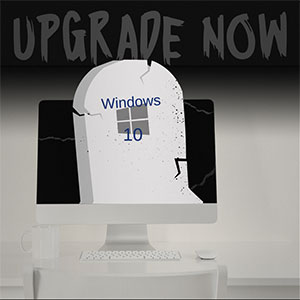 The Countdown to October 14, 2025
The Countdown to October 14, 2025
Mark your calendars—Windows 10 will officially reach its end of life on October 14, 2025. After this date, Microsoft will no longer provide security updates, bug fixes, or technical support for the operating system. But what does this mean for your business applications and productivity tools?
If you continue using Windows 10 beyond the cutoff date, it’s not just your operating system that’s at risk—your critical business applications could be impacted as well. Here’s what you need to know to stay ahead of potential disruptions.
No More Security Updates = Major Vulnerabilities
Once Microsoft ends support for Windows 10, security vulnerabilities discovered after October 14, 2025, will go unpatched. This creates a prime opportunity for cybercriminals to exploit weaknesses in your system.
How This Affects Your Applications:
- Increased Risk of Cyberattacks – Without ongoing security patches, your applications become vulnerable to malware, ransomware, and hacking attempts.
- Compliance Challenges – Businesses in regulated industries, such as healthcare and finance, may face compliance violations for using unsupported software, leading to potential fines.
- Operational Disruptions – A successful cyberattack could bring your business to a halt, causing financial losses and reputational damage.
Compatibility Issues: Software Will Move On
As technology evolves, software vendors will eventually phase out support for Windows 10, meaning new updates and versions may no longer be compatible with your system. This can result in:
- Frequent Crashes & Glitches – Applications may freeze, crash, or fail to launch due to compatibility conflicts.
- Limited Features – New software functionalities will be designed for Windows 11 and beyond, leaving Windows 10 users behind.
- Unpatched Security Gaps – Application updates often include security fixes, but these will be ineffective if the OS itself remains outdated and vulnerable.
Loss of Vendor Support: You’re on Your Own
It’s not just Microsoft ending support—third-party software vendors will follow suit. This means:
- No More Customer Support – If you run into issues with an application, vendors may refuse to troubleshoot problems on an unsupported OS.
- Limited Integration with Modern Tools – New applications and cloud-based services will be optimized for Windows 11, making seamless integration difficult.
- Hardware Compatibility Issues – Future peripherals and hardware may not have drivers available for Windows 10, limiting your upgrade options.
Performance Decline: Outdated Systems = Reduced Productivity
As technology advances, older systems struggle to keep up. Running applications on an outdated OS can cause:
- Slower Performance – Aging software can bog down application speed, frustrating employees and reducing efficiency.
- Increased Downtime – Frequent crashes and system failures can lead to costly operational delays.
- Higher Maintenance Costs – Maintaining outdated systems requires more IT resources, increasing expenses over time.
What Should Your Business Do?
To avoid disruptions and security risks, take proactive steps now:
1. Backup Your Data
Protect your critical business information by ensuring you have reliable backups in place.
2. Plan Your Upgrade Path
- Check Compatibility – Not all computers will support Windows 11. Use Microsoft’s PC Health Check tool to verify your devices.
- Consider Hardware Upgrades – If your current systems can’t run Windows 11, factor in the cost of replacing outdated equipment.
3. Partner with an IT Expert
- Assess Your Needs – A professional IT provider can help evaluate your business applications and identify potential risks.
- Ensure a Smooth Transition – Minimize downtime and security gaps with a structured migration plan.
- Strengthen Cybersecurity – Implement security measures to safeguard your data throughout the upgrade process.
Don’t Wait Until It’s Too Late
The end of Windows 10 support is approaching fast. Waiting until the last minute could expose your business to cyber threats, compliance risks, and lost productivity.
Act now with a FREE Network Assessment. Our IT experts will evaluate your infrastructure, identify potential compatibility issues, and create a seamless transition plan to keep your business secure and efficient.
Click here or call us at (281) 646-1200 to schedule your FREE Network Assessment today!
Stay ahead of the curve—ensure your applications continue running smoothly and securely in a post-Windows 10 world.



